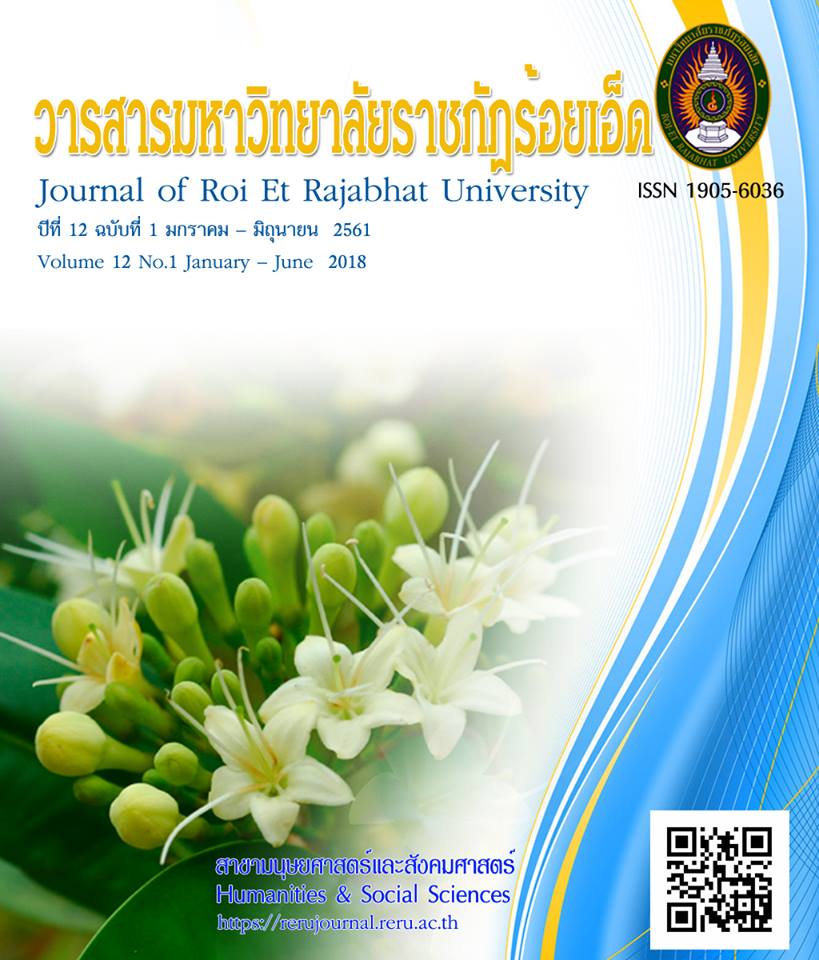Motivational Strategies Affecting Decision Making Behavior of Life Assurance Agents in Roi Et
Keywords:
motivation strategy, life assurance company, decision making behaviorAbstract
This research was aimed 1) to study motivational strategies of life assurance companies affecting decision making behavior of life assurance agents in Roi Et, 2) to compare the decision making behavior of the life assurance agents classified by personal data, and 3) to examine the relationships and the effects of the motivational strategies on the life assurance agents’ decision making behavior to choose life assurance companies. The population included life assurance agents in Roi Et Province. The samples were 381 life assurance agents. This sample size was determined with the method of sample size by Taro Yamane. A questionnaire was constructed to collect the data. The collected data was analyzed through descriptive statistics (frequency, percentage, mean, and standard deviation), comparative statistics (Independent t-test, F–Test, and One way ANOVA), the relationship and impact analysis by Pearson's correlation coefficient and multiple regression analysis. The results revealed that there were 3 major motivational strategies found in life assurance companies; rewarding, working features, and working patterns. The overall level of the 3 motivational strategies was reported “high.” The highest level belonged to working patterns. The comparison of the life assurance agents’ decision making behavior showed that differences in genders, ages, income, educational background, types of work in the assurance career, and assurance companies resulted in different decision making behavior to choose life assurance companies. The examination of the relationships between the motivational strategies and the decision making behavior revealed that the motivational strategies and the decision making behavior had positive relationships at a high level. Analyzing the effects of the 3 motivational strategies, it was found that the 3 motivational strategies also had positive effects on the decision making behavior. The motivational strategy that had the greatest influence on the decision making behavior was rewarding. This finding implies that life assurance companies should focus on developing more rewarding patterns in order to meet various needs of life assurance agents.
References
ชูชัย สมิทธิไกร (2556). จิตวิทยาอุตสาหกรรมและองค์การ. กรุงเทพฯ: สำนักพิมพ์แห่งจุฬาลงกรณ์มหาวิทยาลัย.
ณรงค์ ศรีเกรียงทอง และคณะ. (2558). ปัจจัยแรงจูงใจที่มีผลต่อการสร้างประสิทธิผลในงานขายของพนักงานที่ปรึกษางานขาย (PC) และพนักงานที่ปรึกษาความงาม (BA) ของบริษัทโมเดิร์นคาสอินเตอร์เนชั่นเนลคอสเมติกส์ จำกัด. วารสาร Veridian, 8(2), 1-3.
ธนัท สุขวัฒนาวิทย์. (2556). ปัจจัยที่มีอิทธิพลต่อการตัดสินใจซื้อสินค้าในงานแสดงสินค้าของประชากรในกรุงเทพมหานคร. วิทยานิพนธ์ บริหารธุรกิจมหาบัณฑิต สาขาวิชาบริหารธุรกิจ. กรุงเทพฯ: มหาวิทยาลัยกรุงเทพ.
บุญชม ศรีสะอาด. (2547). การวิจัยเบื้องต้น (พิมพ์ครั้งที่ 7) แก้ไขเพิ่มเติม. กรุงเทพฯ: สุวีรียาสาส์น.
พิชญา วัฒนรังสรรค์ (2558). การเพิ่มประสิทธิภาพในการปฏิบัติงานของพนักงานโรงแรมระดับ 4 ดาวย่าน สยามสแควร์. วิทยานิพนธ์ ศิลปศาสตรมหาบัณฑิต สาขาวิชาการจัดการอุตสาหกรรมการบริการและการท่องเที่ยว. กรุงเทพฯ: มหาวิทยาลัยกรุงเทพ.
ศิริวรรณ เสรีรัตน์ และคณะ. (2538). การบริหารการตลาดยุคใหม่. กรุงเทพฯ: ธีรฟิลม์และไซเท็กซ์
ศุภรัตน์ ถนอมแก้ว. (2559). กลยุทธ์การสร้างแรงจูงใจในแต่ละช่วงวัยของพนักงานในองค์การ. วารสารการจัดการสมัยใหม่, 14(1), 1-16.
สมาคมประกันชีวิตไทย. (2559). สถานการณ์กับช่องทางการขายประกันชีวิต. วารสารประกันชีวิต, 36(153), 53.
Downloads
Published
How to Cite
Issue
Section
License
บทความที่ได้รับการตีพิมพ์เป็นลิขสิทธิ์ของวารสารมหาวิทยาลัยราชภัฎร้อยเอ็ด
ข้อความที่ปรากฏในบทความแต่ละเรื่องในวารสารวิชาการเล่มนี้เป็นความคิดเห็นส่วนตัวของผู้เขียนแต่ละท่านไม่เกี่ยวข้องกับมหาวิทยาลัยราชภัฎร้อยเอ็ด และคณาจารย์ท่านอื่นๆในมหาวิทยาลัยฯ แต่อย่างใด ความรับผิดชอบองค์ประกอบทั้งหมดของบทความแต่ละเรื่องเป็นของผู้เขียนแต่ละท่าน หากมีความผิดพลาดใดๆ ผู้เขียนแต่ละท่านจะรับผิดชอบบทความของตนเองแต่ผู้เดียว





